
Mickey Mouse Works is an American animated television series produced by Walt Disney Television Animation featuring Mickey Mouse and his friends in a series of animated shorts. The first Disney television animated series to be produced in widescreen high definition, it is formatted as a variety show, with skits starring Mickey Mouse, Minnie Mouse, Donald Duck, Daisy Duck, Goofy, Pluto and Ludwig Von Drake while Horace Horsecollar, Clarabelle Cow, Morty and Ferdie Fieldmouse, Huey, Dewey and Louie, Chip 'n' Dale, Scrooge McDuck, Pete, Humphrey the Bear, J. Audubon Woodlore, Dinah the Dachshund, Butch the Bulldog, Mortimer Mouse, José Carioca, and Clara Cluck appear as supporting or minor characters. Musical themes for each character were composed by Stephen James Taylor with a live 12-piece band and extensive use of the fretless guitar to which the music of the series was nominated for an Annie Award in both 1999 and 2001. Most of the shorts from the series were later used in House of Mouse.

The Alice Comedies are a series of animated/live-action shorts created by Walt Disney in the 1920s, in which a live action little girl named Alice and an animated cat named Julius have adventures in an animated landscape. The shorts were the first work by what ultimately became The Walt Disney Company.

Minerva "Minnie" Mouse is an American cartoon character created by the Walt Disney Company. As the longtime sweetheart of Mickey Mouse, she is an anthropomorphic mouse with white gloves, a red or pink bow, blue polka-dotted dress, white bloomers and low-heeled shoes occasionally with ribbons on them. The Mickey Mouse comic strip story "The Gleam" by Merrill De Maris and Floyd Gottfredson first gave her full name as Minerva Mouse, although this is seldom used.

The golden age of American animation was a period in the history of U.S. animation that began with the popularization of sound synchronized cartoons in 1928 and gradually ended in the 1960s when theatrical animated shorts started to lose popularity to the newer medium of television. Animated media from after the golden age, especially on television, were produced on cheaper budgets and with more limited techniques between the 1960s and 1980s.
Hugh Harman and Rudolf Ising were an American animation team and company known for founding the Warner Bros. and Metro-Goldwyn-Mayer animation studios. In 1929, the studio was founded under the name Harman-Ising Productions, producing Looney Tunes and Merrie Melodies for Leon Schlesinger from 1930 to 1933. From 1934 to 1938, Harman-Ising produced the Happy Harmonies series, with William Hanna as their employee.
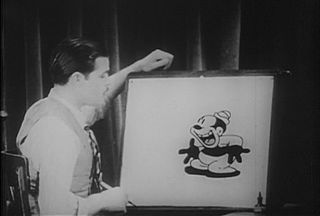
Rudolf Carl Ising was an American animator best known for collaborating with Hugh Harman to establish the Warner Bros. and MGM Cartoon studios during the early years of the golden age of American animation. In 1940, Ising produced William Hanna and Joseph Barbera's first cartoon, Puss Gets the Boot, a cartoon featuring characters later known as Tom and Jerry.

Alice in Wonderland is a 1951 American animated musical fantasy comedy film produced by Walt Disney Productions and released by RKO Radio Pictures. It is based on Lewis Carroll's 1865 novel Alice's Adventures in Wonderland and its 1871 sequel Through the Looking-Glass. The production was supervised by Ben Sharpsteen, and was directed by Clyde Geronimi, Wilfred Jackson, and Hamilton Luske. With the voices of Kathryn Beaumont, Ed Wynn, Richard Haydn, Sterling Holloway, Jerry Colonna, Verna Felton, J. Pat O'Malley, Bill Thompson, and Heather Angel, the film follows a young girl Alice who falls down a rabbit hole to enter a nonsensical world Wonderland that is ruled by the Queen of Hearts, while encountering strange creatures, including the Mad Hatter and the Cheshire Cat.
Charles Bear Mintz was an American film producer and distributor who assumed control over Margaret J. Winkler's Winkler Pictures after marrying her in 1924. The couple had two children, Katherine and William. Between 1925 and 1939, Mintz produced over 370 cartoon shorts.

Donald's Ostrich is an animated short film produced in Technicolor by Walt Disney Productions and released to theaters on December 10, 1937, by RKO Radio Pictures. It was the first film in the Donald Duck series of short films, although billed at the time as a Mickey Mouse cartoon. It was the first of the series to be released by RKO.
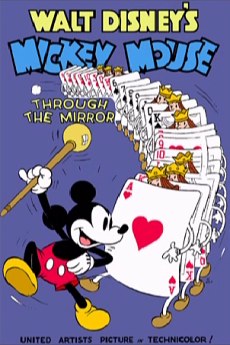
Thru the Mirror is a 1936 American animated short film directed by David Hand from a story by William Cottrell and Joe Grant. In this cartoon short, Mickey Mouse has a Through the Looking-Glass-parody-like dream that he travels through his mirror and enters a topsy-turvy world where everything is alive. While there, he engages in a Fred Astaire dance number with a pair of gloves and a pack of cards, until the cards chase him out of the bizarre world. Produced by Walt Disney Productions and released by United Artists, it was the 83rd Mickey Mouse short film to be released, the fourth of that year.
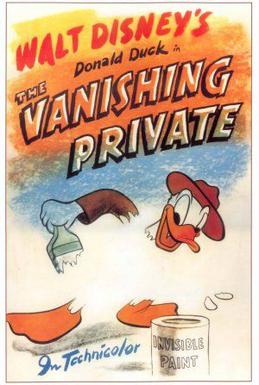
The Vanishing Private is a 1942 animated cartoon directed by Jack King and produced by Walt Disney. In the cartoon, Donald Duck is ordered to paint a cannon with experimental invisible paint while serving as a private in the United States Army during World War II.

Bugged by a Bee is a 1969 Warner Bros. Looney Tunes animated cartoon directed by Robert McKimson. It starred Cool Cat, and was the final cartoon from the original Looney Tunes/Merrie Melodies series to bear the Looney Tunes name, and the last from that era to be widely released. One more cartoon, Injun Trouble, would follow Bugged by a Bee, but it was in the Merrie Melodies series.
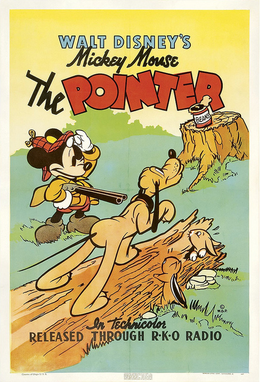
The Pointer is an American animated short film produced by Walt Disney Productions and released by RKO Radio Pictures on July 21, 1939, shown in theaters with Way Down South. The short was directed by Clyde Geronimi and animated by Fred Moore, Frank Thomas, Lynn Karp, Seamus Culhane, Ollie Johnston, Preston Blair, Lester Norvi, John Lounsbery, Claude Smitha, Art Palmer, and Josh Meador. The film was nominated for an Academy Award for Best Short Subject (Cartoon) in 1940. It was the 106th short in the Mickey Mouse film series to be released, and the third for that year.
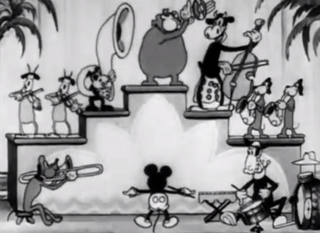
Blue Rhythm is a 1931 Mickey Mouse animated short film directed by Burt Gillett, produced by Walt Disney Productions and distributed by Columbia Pictures. It was the 31st short in the Mickey Mouse film series, and the seventh of that year. The plot focuses on a multifaceted performance of W. C. Handy's "St. Louis Blues". The film features the voices of Walt Disney as Mickey and Marcellite Garner as Minnie Mouse.
The Roger Rabbit shorts are a series of three animated short films produced by Walt Disney Feature Animation from 1989 to 1993. They feature Roger Rabbit, the animated protagonist from Who Framed Roger Rabbit (1988), being enlisted the task of caring for Baby Herman while his mother is absent, resulting in a plot defined by slapstick humor and visual gags. Each short concludes with a sequence involving live-action and animation, where the characters interact with live-action human beings, akin to the 1988 film. Droopy Dog from MGM makes a cameo in all of the shorts.
Alice the Toreador is a 1925 animated short film by Walt Disney in the Alice Comedies series.

Julius the Cat is a fictional anthropomorphic cat created in 1922 by Walt Disney and Ub Iwerks. He first appeared in the very first animated series created by Disney, the Alice Comedies, making him the predecessor of Oswald the Lucky Rabbit and Mickey Mouse. Julius is an anthropomorphic cat, appearing intentionally similar to Felix the Cat. A bold and inventive hero, he gradually became the primary focus of the Alice Comedies, to the point Disney abandoned live action for pure animation on subsequent projects.

Beezy Bear is a 1955 Disney animated short featuring Donald Duck, who appears as a beekeeper. This is Humphrey the Bear's fifth appearance. The cartoon portrays Humphrey as a honey-stealing bear.
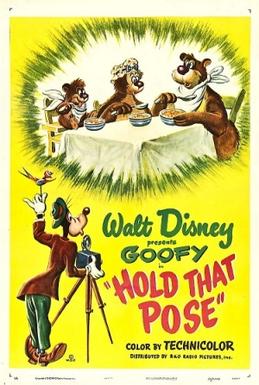
Hold That Pose is a 1950 American animated cartoon produced by Walt Disney Productions and released by RKO Radio Pictures. The film's plot centers on Goofy trying to get a job as a wildlife photographer but ending up causing trouble in a grizzly bear's pen at a zoo. This is Humphrey the Bear's debut appearance.















